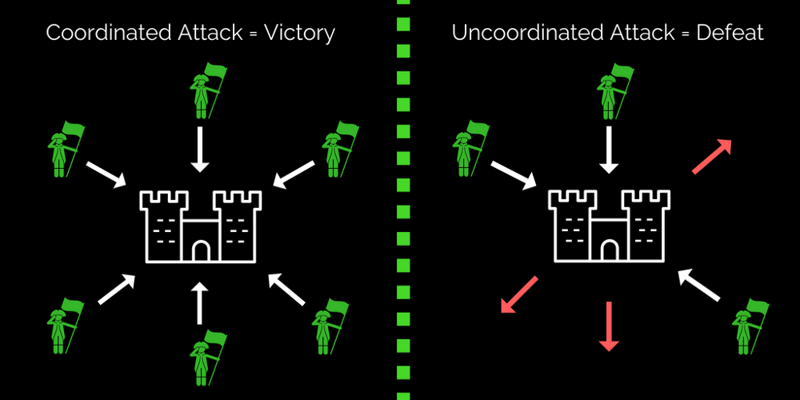Imagine you are in charge of a medieval army storming a walled city.
The attackers and defenders are equal in strength.
The only way the attackers can win is if all the generals successfully coordinate their attack. If even one fails to coordinate, the entire attack will fail.
Complicating matters is the fact there might be some spies among your generals who deliberately pass on false information to sabotage the attack.
The problem is, how do you get them all to coordinate the attack successfully?
This is what is known as the Byzantine Generals Problem. It was a longstanding problem in computer science.
In short, it’s the problem of getting different people—who may be hostile to each other—to come to a consensus about something without a trusted arbitrator of truth.
Before Bitcoin, this was not possible.
Obtaining consensus required a centralized party.
Think of a traditional bank that you use.
The bank is needed to keep an internal ledger of accounts and balances, including your balance and transaction history.
It would be impossible to keep accurate records without a trusted centralized entity determining what is true for everyone in this situation.
Now imagine an innovation that removes the need for the centralized entity (the bank) to keep an accurate record of all the accounts, balances, and transactions.
It effectively allows everyone to be their own sovereign bank without needing trusted third parties… and is at the same time the most inflation-resistant money the world has ever known.
Now, that’s a disruptive technology… and that’s what Proof of Work allows Bitcoin to do.
Proof of Work
You might be wondering, what gives Bitcoin’s absolute scarcity credibility?
Couldn’t someone change the supply?
The key to understanding the credibility of Bitcoin’s fixed monetary policy is with the full nodes and in the mining process, which combined form an ingenious system of economic incentives that secure the Bitcoin network in a genuinely decentralized fashion.
Let’s start with the basics and build from there to get clarity on this often misunderstood topic.
Bitcoin is open-source software, which means its code is available for anyone to download, inspect, suggest changes, and run.
Think of the Bitcoin blockchain as simply a public database of transactions distributed to over 14,000 computers worldwide. The computers that retain the entire blockchain and run the Bitcoin software are called “full nodes.”
Full nodes enforce the Bitcoin protocol and consensus rules—like its monetary policy. They can also verify and audit the entire supply and transaction history—without relying on third parties.
Bitcoin needs enough full nodes to protect against centralization and capture by hostile forces—like governments and financial institutions.
How many full nodes are enough to achieve this security?
Nobody knows for sure.
However, it seems the current number has been capable of doing the job.
If a hostile entity wanted to change Bitcoin’s parameters, among other things, it would need to attack all the full nodes all around the world simultaneously.
For example, imagine that Bitcoin had only 15 full nodes, all located in China. It would be feasible for the Chinese government—or another attacker—to simultaneously target or compromise all 15 nodes. It would be the death of Bitcoin as we know it.
However, simultaneously attacking 14,000 full nodes worldwide—some cleverly hidden—is an entirely different matter. So far, it’s proved to be impossible.
The more full nodes there are, the more secure Bitcoin is. So it’s crucial the average person can easily operate one.
The table below lists the majority (51%) of nodes as “n/a,” meaning the node owners have taken measures to conceal their physical locations, improving privacy and making them much harder to attack.

Source: Bitnodes.io
I am not a fan of the term “mining” because it confuses what is happening.
The process of Bitcoin mining is better thought of as a competition with finite rewards, like winning a gold medal in the Olympics.
About every 10 minutes, Bitcoin miners submit a new block—or set of transactions—to the full nodes, adding it to the existing database (blockchain), but only if the miner’s block follows the protocol.
If the full nodes verify the block as valid, the miner will earn the Block Reward.
The Block Reward consists of the Block Subsidy—newly created Bitcoins in each block—and Transaction Fees.
The Block Subsidy is currently 6.25 Bitcoin per block and is cut in half every four years—or approximately 210,000 blocks—until it reaches 0 in the year 2140.
The Block Subsidy will remain 6.25 BTC until May 2024, when it will be halved to 3.125 BTC.
The other component of the Block Reward is the Transaction Fees.
Think of the digital space on each Bitcoin block as scarce real estate on an immutable ledger.
Whenever you make a Bitcoin transaction, you must pay a fee for Bitcoin miners to inscribe it onto the next block of the blockchain.
These transaction fees are a simple matter of economics—supply and demand for scarce Bitcoin block space. It’s an excellent illustration of a competitive free market at work.
Whenever you make a Bitcoin transaction, you are bidding against everyone else in the world to get your transaction inscribed onto the next block through the transaction fee.
The higher the fee you pay, the faster miners will finalize your transaction, which means it has been added to the blockchain.
Naturally, transaction fees vary widely. It has swung from being as cheap as $0.05 to get your transaction included in the next block to over $40.
However, before a Bitcoin miner can submit a new block to the network of full nodes—and thus earn the rewards of 6.25 of freshly created Bitcoins and transaction fees—they must compete to solve complex math problems that are difficult to solve but easy to verify.
The first miner to solve the math problem has the chance to propose a new block to the network and thus earn the rewards. The process then starts over again.
Depending on the aggregate amount of computing power miners contribute, the Bitcoin protocol automatically adjusts the difficulty of these math problems every two weeks so that, on average, it takes about 10 minutes for miners to solve and thus generate a new block.
This brilliant feature—called the Difficulty Adjustment—is why, no matter how high the Bitcoin price goes, it cannot incentivize miners to produce more Bitcoins than what the protocol has preset.
At first glance, it all may seem unnecessary—as the complex math problems are unrelated to the transactions—but it’s a crucial part of ensuring the Bitcoin network is self-sufficient, incentivized to be honest, and doesn’t deviate from the consensus protocol.
It’s what makes Bitcoin work without anybody in charge of it.
Miners must incur real-world costs—expensive computer hardware and massive amounts of electricity—to solve these math problems and have the chance to submit a new block to the network to earn the rewards.
If the block they submit doesn’t follow the Bitcoin protocol or is otherwise invalid, the network of full nodes will instantly reject it.
If that happens, the miner will not earn any rewards despite incurring enormous costs to submit the block in the first place.
The genius of Bitcoin’s security model is that it is difficult and expensive for miners to submit a new block, but easy, cheap, and fast for the network to verify whether that block is legitimate or not.
Bitcoin analyst Preston Pysh has come up with a helpful way to think of this.
Think of a Bitcoin miner like a person who puts together a large and complex jigsaw puzzle. It takes a lot of time and work to put it all together.
Then think of the global network of full nodes as puzzle checkers. Each one of them verifies the work of the miners.
It’s like how someone can look at a complete jigsaw puzzle and quickly see that it was put together correctly.
It’s easier to check the work than to do the work.
In other words, it’s quick, cheap, and easy for the puzzle checkers (full nodes) to verify that the miners completed the jigsaw puzzle correctly.
That’s the essence of the asymmetry in Bitcoin’s security model.
If a miner ever tried to stray from the Bitcoin protocol or include invalid transactions in the block, the full nodes would easily detect and instantly reject it.
It would be not only a fruitless effort for the renegade miner but would impose actual costs on them. They would need to use an enormous amount of electricity and processing power to solve the math problem in the first place.
In other words, it takes a lot of effort and costs a lot of money to propose a new block to the Bitcoin network, and if the miner isn’t following the protocol, then it will waste all that money.
It’s essential to clarify a common misunderstanding here.
Miners do not control Bitcoin.
Bitcoin proponent Saifedean Ammous said it best: “Miners are Bitcoin’s slaves, not masters.”
Saifedean means that the miners must satisfy the Bitcoin network—not the other way around.
Miners must follow the Bitcoin protocol and be honest. If they don’t, they will do nothing but waste money and eventually bankrupt themselves.
This is how Bitcoin’s essential “Proof of Work” system works.
Solving the Byzantine Generals Problem
Satoshi Nakamoto—Bitcoin’s anonymous cypherpunk creator—once said, “Proof-of-work has the nice property that it can be relayed through untrusted middlemen.”
Proof of Work makes it possible for a decentralized network of thousands of computers worldwide to reach a consensus on the entire transaction history—without the need for a trusted third party or any intermediary.
It’s a truly disruptive innovation in computer engineering, accounting, and money.
Bitcoin’s Proof of Work system solved the Byzantine Generals Problem. It’s a genuine paradigm shift.
Proof of Work makes Bitcoin resistant to being captured, controlled, or manipulated. It makes Bitcoin credibly inflation-proof and absolutely scarce, giving it its superior monetary properties as a neutral hard money.
There is simply no substitute for Bitcoin’s Proof of Work system. It’s the only way we know of today to have a genuinely decentralized monetary system beyond anyone’s ability to control.
The implications of that are profound.
I think Bitcoin has revolutionary potential, as much or more than the printing press, the invention of gunpowder, the Internet, and other historical innovations that overturned established paradigms.
Understanding the Byzantine Generals Problem and how Bitcoin’s Proof of Work system solved it is essential to understanding the mind-bending profit opportunity in front of us today.
That’s precisely why I just released an urgent free PDF report.
It’s called, The Bitcoin Supremacy—How Bitcoin Becomes the World’s Dominant Money.







